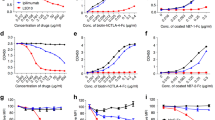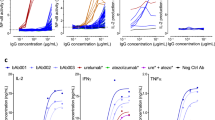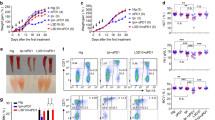Abstract
MuS110 is a BiTE antibody bispecific for murine EpCAM (CD326) and murine CD3. A recent study has shown that muS110 has significant anti tumor activity at well-tolerated doses as low as 5 μg/kg in orthotopic breast and lung cancer models (Amann et al. in Cancer Res 68:143–151, 2008). Here, we have explored the safety profile of muS110 at higher doses. Escalation to 50 μg/kg muS110 caused in mice transient loss of body weight, and transient piloerection, hypomotility, hypothermia and diarrhoea. These clinical signs coincided with serum peaks of TNF-α, IL-6, IL-2, IFN-γ and IL-4, and an increase of surface markers for T cell activation. Because activation of T cells in response to BiTE antibodies is typically dependent on target cells, we analyzed mouse blood for the presence of EpCAM+ cells. Various mouse strains presented with a subpopulation of 2–3% EpCAM+ blood cells, mostly B and T lymphocytes, which was not detected in human blood samples. In vitro experiments in which the number of EpCAM+ cells in blood samples was either reduced or increased suggested that both T cell activation and cytokine release in response to muS110 was dependent on the number of target-expressing cells. In support for a role of EpCAM+ lymphocytes in the observed side effects, reduction of EpCAM+ blood cells in mice via a low-dose pre treatment with muS110 dramatically increased the tolerability of animals up to at least 500 μg/kg of the BiTE antibody. This high tolerability to muS110 occurred in the presence of non-compromised T cells. No damage to EpCAM+ epithelial tissues was evident from histopathological examination of animals daily injected with 100 μg/kg muS110 for 28 days. In summary, these observations suggest that side effects of muS110 in mice were largely caused by an acute T cell activation that was triggered by a subpopulation of EpCAM+ lymphocytes. Because humans have extremely low numbers of EpCAM+ cells in blood, this toxicity of an EpCAM-specific BiTE may be specific for mice.






Similar content being viewed by others
References
Alegre M, Depierreux M, Florquin S, Najdovski T, Vandenabeele P, Abramowicz D, Leo O, Deschodt-Lanckman M, Goldman M (1990) Acute toxicity of anti-CD3 monoclonal antibody in mice: a model for OKT3 first dose reactions. Transplant Proc 22:1920–1921
Alegre M, Vandenabeele P, Flamand V, Moser M, Leo O, Abramowicz D, Urbain J, Fiers W, Goldman M (1990) Hypothermia and hypoglycemia induced by anti-CD3 monoclonal antibody in mice: role of tumor necrosis factor. Eur J Immunol 20:707–710
Alegre ML, Vandenabeele P, Depierreux M, Florquin S, Deschodt-Lanckman M, Flamand V, Moser M, Leo O, Urbain J, Fiers W et al (1991) Cytokine release syndrome induced by the 145-2C11 anti-CD3 monoclonal antibody in mice: prevention by high doses of methylprednisolone. J Immunol 146:1184–1191
Amann M, Brischwein K, Lutterbuese P, Parr L, Petersen L, Lorenczewski G, Krinner E, Bruckmeier S, Lippold S, Kischel R, Lutterbuese R, Kufer P, Baeuerle PA, Schlereth B (2008) Therapeutic window of MuS110, a single-chain antibody construct bispecific for murine EpCAM and murine CD3. Cancer Res 68:143–151
Ariel A, Yavin EJ, Hershkoviz R, Avron A, Franitza S, Hardan I, Cahalon L, Fridkin M, Lider O (1998) IL-2 induces T cell adherence to extracellular matrix: inhibition of adherence and migration by IL-2 peptides generated by leukocyte elastase. J Immunol 161:2465–2472
Baeuerle PA, Gires O (2007) EpCAM (CD326) finding its role in cancer. Br J Cancer 96:417–423
Baeuerle PA, Reinhardt C, Kufer P (2008) BiTE: a new class of antibodies that recruit T-cells. Drugs Future 33(2):1–11
Bargou R, Noppeney R, Schuler M, Hess G, Gerecke C, Zettl F, Birkmann J, Viardot A, Kirchinger P, Baeuerle P, Reinhardt C, Klinger M, Libicher M, Goebeler M, Einsele H, Kufer P, Zugmaier G, Leo E (2006) The bi-specific T-cell enhancer (BiTE) MT103 (MEDI-538) induces clinical responses in heavily pre-treated NHL patients: update from the ongoing phase I study MT103-104. Blood 108:693 (ASH Annual Meeting Abstracts)
Bargou RC, Kufer P, Goebeler M, Knop S, Einsele H, Noppeney R, Viardot A, Hess G, Riethmueller G, Reitsma D, Leo E, Reinhardt C, Zugmaier G (2007) The anti-CD19 bispecific T-cell engager (BiTE) MT103 (MEDI-538), induces dose-dependent complete and partial responses in relapsed non-Hodgkin’s lymphoma (NHL): phase I study MT103–104. ASH Annu Meet Abstr 110:2557
Barnes PJ (1998) Anti-inflammatory actions of glucocorticoids: molecular mechanisms. Clin Sci (Lond) 94:557–572
Blackwell TS, Christman JW (1996) Sepsis and cytokines: current status. Br J Anaesth 77:110–117
Borkowski TA, Nelson AJ, Farr AG, Udey MC (1996) Expression of gp40, the murine homologue of human epithelial cell adhesion molecule (Ep-CAM), by murine dendritic cells. Eur J Immunol 26:110–114
Brandl C, Haas C, d‘Argouges S, Fisch T, Kufer P, Brischwein K, Prang N, Bargou R, Suzich J, Baeuerle PA, Hofmeister R (2007) The effect of dexamethasone on polyclonal T cell activation and redirected target cell lysis as induced by a CD19/CD3-bispecific single-chain antibody construct. Cancer Immunol Immunother 56:1551–1563
Brischwein K, Schlereth B, Guller B, Steiger C, Wolf A, Lutterbuese R, Offner S, Locher M, Urbig T, Raum T, Kleindienst P, Wimberger P, Kimmig R, Fichtner I, Kufer P, Hofmeister R, da Silva AJ, Baeuerle PA (2006) MT110: a novel bispecific single-chain antibody construct with high efficacy in eradicating established tumors. Mol Immunol 43:1129–1143
Brischwein K, Parr L, Pflanz S, Volkland J, Lumsden J, Klinger M, Locher M, Hammond SA, Kiener P, Kufer P, Schlereth B, Baeuerle PA (2007) Strictly target cell-dependent activation of T cells by bispecific single-chain antibody constructs of the BiTE class. J Immunother 30:798–807
Buysmann S, Bemelman FJ, Schellekens PT, van Kooyk Y, Figdor CG, ten Berge IJ (1996) Activation and increased expression of adhesion molecules on peripheral blood lymphocytes is a mechanism for the immediate lymphocytopenia after administration of OKT3. Blood 87:404–411
Carter PJ (2006) Potent antibody therapeutics by design. Nat Rev Immunol 6:343–357
Charpentier B, Hiesse C, Ferran C, Lantz O, Fries D, Bach JF, Chatenoud L (1991) Acute clinical syndrome associated with OKT3 administration. Prevention by single injection of an anti-human TNF monoclonal antibody. Presse Med 20:2009–2011
Chatenoud L, Ferran C, Bach JF (1991) The anti-CD3-induced syndrome: a consequence of massive in vivo cell activation. Curr Top Microbiol Immunol 174:121–134
Chatenoud L, Legendre C, Ferran C, Bach JF, Kreis H (1991) Corticosteroid inhibition of the OKT3-induced cytokine-related syndrome–dosage and kinetics prerequisites. Transplantation 51:334–338
Desjarlais JR, Lazar GA, Zhukovsky EA, Chu SY (2007) Optimizing engagement of the immune system by anti-tumor antibodies: an engineer’s perspective. Drug Discov Today 12:898–910
Ferran C, Dy M, Sheehan K, Merite S, Schreiber R, Landais P, Grau G, Bluestone J, Bach JF, Chatenoud L (1991) Inter-mouse strain differences in the in vivo anti-CD3 induced cytokine release. Clin Exp Immunol 86:537–543
Gottlinger H, Johnson J, Riethmuller G (1986) Biochemical and epitope analysis of the 17–1A membrane antigen. Hybridoma 5(Suppl 1):S29–S37
Green DM, Trial J, Birdsall HH (1998) TNF-alpha released by comigrating monocytes promotes transendothelial migration of activated lymphocytes. J Immunol 161:2481–2489
Hayashi R, Wada H, Ito K, Adcock IM (2004) Effects of glucocorticoids on gene transcription. Eur J Pharmacol 500:51–62
Hirsch R, Gress RE, Pluznik DH, Eckhaus M, Bluestone JA (1989) Effects of in vivo administration of anti-CD3 monoclonal antibody on T cell function in mice. II. In vivo activation of T cells. J Immunol 142:737–743
Kaufman RJ (1990) Selection and coamplification of heterologous genes in mammalian cells. Methods Enzymol 185:537–566
Klinger M, Kufer P, Kirchinger P, Lutterbuse R, Leo E, Reinhardt C, Bauerle P and Bargou R (2006) T cell responses during long-term continuous infusion of MT103 (MEDI-538; anti-CD19 BiTE) in patients with relapsed B-NHL: data from dose-escalation study MT103-104. Blood 108:2725 (ASH Annual Meeting Abstracts)
Kontermann RE (2005) Recombinant bispecific antibodies for cancer therapy. Acta Pharmacol Sin 26:1–9
Kufer P, Zettl F, Borschert K, Lutterbuse R, Kischel R, Riethmuller G (2001) Minimal costimulatory requirements for T cell priming and TH1 differentiation: activation of naive human T lymphocytes by tumor cells armed with bifunctional antibody constructs. Cancer Immunol 1:10
Lambert JM (2005) Drug-conjugated monoclonal antibodies for the treatment of cancer. Curr Opin Pharmacol 5:543–549
Mack M, Riethmuller G, Kufer P (1995) A small bispecific antibody construct expressed as a functional single-chain molecule with high tumor cell cytotoxicity. Proc Natl Acad Sci USA 92:7021–7025
Miyamoto T, Fujinaga T, Yamashita K, Hagio M (1996) Changes of serum cytokine activities and other parameters in dogs with experimentally induced endotoxic shock. Jpn J Vet Res 44:107–118
Moldenhauer G, Momburg F, Moller P, Schwartz R, Hammerling GJ (1987) Epithelium-specific surface glycoprotein of Mr 34, 000 is a widely distributed human carcinoma marker. Br J Cancer 56:714–721
Nelson AJ, Dunn RJ, Peach R, Aruffo A, Farr AG (1996) The murine homolog of human Ep-CAM, a homotypic adhesion molecule, is expressed by thymocytes and thymic epithelial cells. Eur J Immunol 26:401–408
Panelli MC, White R, Foster M, Martin B, Wang E, Smith K, Marincola FM (2004) Forecasting the cytokine storm following systemic interleukin (IL)-2 administration. J Transl Med 2:17
Rao CG, Chianese D, Doyle GV, Miller MC, Russell T, Sanders RA Jr., Terstappen LW (2005) Expression of epithelial cell adhesion molecule in carcinoma cells present in blood and primary and metastatic tumors. Int J Oncol 27:49–57
Raum T, Gruber R, Riethmuller G, Kufer P (2001) Anti-self antibodies selected from a human IgD heavy chain repertoire: a novel approach to generate therapeutic human antibodies against tumor-associated differentiation antigens. Cancer Immunol Immunother 50:141–150
Schlereth B, Fichtner I, Lorenczewski G, Kleindienst P, Brischwein K, da Silva A, Kufer P, Lutterbuese R, Junghahn I, Kasimir-Bauer S, Wimberger P, Kimmig R, Baeuerle PA (2005) Eradication of tumors from a human colon cancer cell line and from ovarian cancer metastases in immunodeficient mice by a single-chain Ep-CAM-/CD3-bispecific antibody construct. Cancer Res 65:2882–2889
Schlereth B, Kleindienst P, Fichtner I, Lorenczewski G, Brischwein K, Lippold S, da Silva A, Locher M, Kischel R, Lutterbuse R, Kufer P, Baeuerle PA (2006) Potent inhibition of local and disseminated tumor growth in immunocompetent mouse models by a bispecific antibody construct specific for Murine CD3. Cancer Immunol Immunother 55:785–796
Schlereth B, Quadt C, Dreier T, Kufer P, Lorenczewski G, Prang N, Brandl C, Lippold S, Cobb K, Brasky K, Leo E, Bargou R, Murthy K, Baeuerle PA (2006) T-cell activation and B-cell depletion in chimpanzees treated with a bispecific anti-CD19/anti-CD3 single-chain antibody construct. Cancer Immunol Immunother 55:503–514
Stern M, Herrmann R (2005) Overview of monoclonal antibodies in cancer therapy: present and promise. Crit Rev Oncol Hematol 54:11–29
Talmadge JE, Bowersox O, Tribble H, Lee SH, Shepard HM, Liggitt D (1987) Toxicity of tumor necrosis factor is synergistic with gamma-interferon and can be reduced with cyclooxygenase inhibitors. Am J Pathol 128:410–425
Weiner LM (2000) Bispecific antibodies in cancer therapy. Cancer J 6(Suppl 3):S265–S271
Went P, Vasei M, Bubendorf L, Terracciano L, Tornillo L, Riede U, Kononen J, Simon R, Sauter G, Baeuerle PA (2006) Frequent high-level expression of the immunotherapeutic target Ep-CAM in colon, stomach, prostate and lung cancers. Br J Cancer 94:128–135
Wissing KM, Desalle F, Abramowicz D, Willems F, Leo O, Goldman M, Alegre ML (1999) Down-regulation of interleukin-2 and interferon-gamma and maintenance of interleukin-4 and interleukin-10 production after administration of an anti-CD3 monoclonal antibody in mice. Transplantation 68:677–684
Wolf E, Hofmeister R, Kufer P, Schlereth B, Baeuerle PA (2005) BiTEs: bispecific antibody constructs with unique anti-tumor activity. Drug Discov Today 10:1237–1244
Author information
Authors and Affiliations
Corresponding author
Additional information
M. Amann and M. Friedrich contributed equally to this work.
Rights and permissions
About this article
Cite this article
Amann, M., Friedrich, M., Lutterbuese, P. et al. Therapeutic window of an EpCAM/CD3-specific BiTE antibody in mice is determined by a subpopulation of EpCAM-expressing lymphocytes that is absent in humans. Cancer Immunol Immunother 58, 95–109 (2009). https://doi.org/10.1007/s00262-008-0529-y
Received:
Accepted:
Published:
Issue Date:
DOI: https://doi.org/10.1007/s00262-008-0529-y




